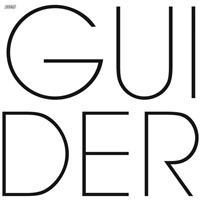 Disappears: Guider (Kranky, 1/17/11)
Disappears: Guider (Kranky, 1/17/11)
Disappears: “Halo”
[audio:https://alarm-magazine.com/wp-content/uploads/2011/03/Halo.mp3|titles=Disappears: “Halo”]Chicago-based rock band Disappears feels pigeonholed. After having just released its second album, Guider, in January, the same words seem to keep popping up like shampoo instructions in various descriptions of its music: echo, fuzz, psych, kraut. The terms aren’t off base, but the band would like to think that it has a few different tricks up its sleeve. Here to address this limited vocabulary, vocalist Brian Case (formerly of The Ponys and 90 Day Men) breaks down the most recycled lingo while explaining the band’s key elements.
The Basic Elements of Disappears’ Music
by Disappears
Roland Space Echo
Used by everyone from King Tubby to KISS, the Roland Space Echo (specifically the RE-201) is a not-so-secret weapon for us. Every vocal track this band has ever recorded has been run through one of these — as well as every instruments on our recordings at one point or another. The RE-201 is a simple system in which a small loop of tape records an incoming signal and immediately plays the recorded sound back over a couple playback heads before being erased over by new incoming audio. Being an analog-tape effect, the results are usually unpredictable. It’s the cool sounds you hear on dub records and the crazy sci-fi sounds in Twilight Zone episodes. We try and tastefully split the difference, although I really want our next record to be super dubbed out, so we’ll see.
Reverb
This comes up as a compliment as much as a criticism. Basically, reverb is the persistence of sound after the original sound has been removed. Reverb simulates a build-up of echoes in a certain space, making whatever you’re playing — guitar, drums, vocals — enter, rise to a peak, and then die off. The way we use it, it’s constantly falling back in on itself — we do a lot of down-stroke strumming in this band, coupled with single notes, and the small waves made by the effect never die off, but continue to hold each other up as well as blur and disorient.
Some people say it’s a crutch or cover (which it can be), but when used in the right way and in the right amount, it creates a dense and dramatic atmosphere. It’s used so well (Liars‘ Drum’s Not Dead) and so poorly (drums on any big rock record in the mid- to late ’80s) that really getting it can take a bit. [It’s] worth the time, for sure.
Repetition
The best way for me to explain this to you would be to have you do the same thing for three minutes. [It] doesn’t matter what — tap your pencil on the desk and time it. At some point, you’ll get bored and frustrated, and that will turn to tension, which will lead to a real physical response. You’ll focus really hard on what you’re doing, and then you’ll overcome that and be in a different place where you’re not thinking about what you’re doing at all. [It] sounds like bullshit, but when you’re doing small things like that over a larger course of time, it has a meditation-like effect on you. We don’t always work this way (as not every song is right for it), but we always focus on keeping things stripped down and simple so that it’s as easy as possible to fall into these patterns when we can.
Mark E. Smith / Alan Vega
I cannot sing. It’s a fact. Disappears’ music is such that I can zone in on two people who’ve had a big impact on me and it makes sense. Between Mark E. Smith’s casual, caustic drawl and Alan Vega’s fake Elvis howls and delayed-out mantras, I’ve found my place. I just need to start smoking again and whipping a chain around to make the combination complete.
[Have you pre-ordered yet? Don’t miss our limited-time offer, saving up to 38%, for Chromatic: The Crossroads of Color and Music, our next book that profiles independent musicians and artists who explore color in unorthodox ways.]

